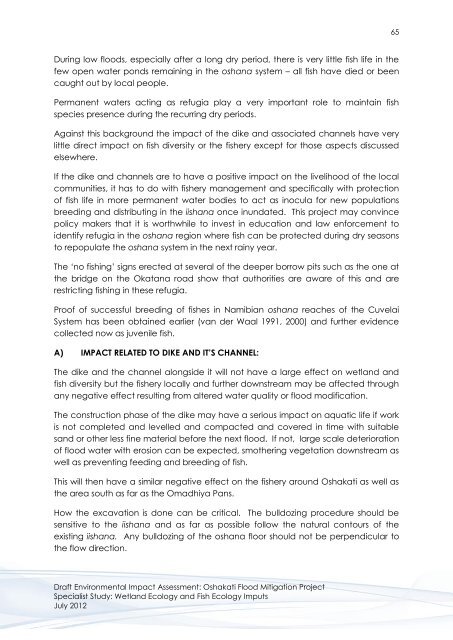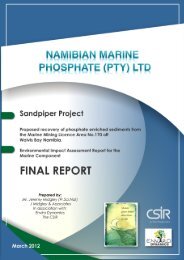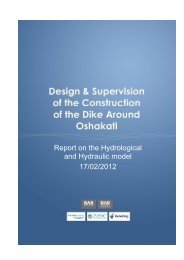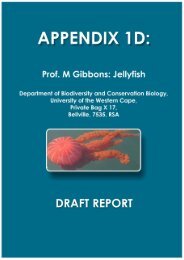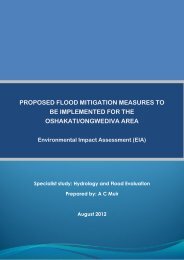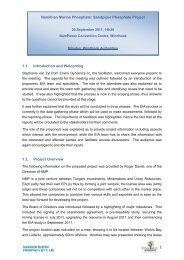Wetland & Fish Ecology - Enviro Dynamics Namibia
Wetland & Fish Ecology - Enviro Dynamics Namibia
Wetland & Fish Ecology - Enviro Dynamics Namibia
Create successful ePaper yourself
Turn your PDF publications into a flip-book with our unique Google optimized e-Paper software.
65<br />
During low floods, especially after a long dry period, there is very little fish life in the<br />
few open water ponds remaining in the oshana system – all fish have died or been<br />
caught out by local people.<br />
Permanent waters acting as refugia play a very important role to maintain fish<br />
species presence during the recurring dry periods.<br />
Against this background the impact of the dike and associated channels have very<br />
little direct impact on fish diversity or the fishery except for those aspects discussed<br />
elsewhere.<br />
If the dike and channels are to have a positive impact on the livelihood of the local<br />
communities, it has to do with fishery management and specifically with protection<br />
of fish life in more permanent water bodies to act as inocula for new populations<br />
breeding and distributing in the iishana once inundated. This project may convince<br />
policy makers that it is worthwhile to invest in education and law enforcement to<br />
identify refugia in the oshana region where fish can be protected during dry seasons<br />
to repopulate the oshana system in the next rainy year.<br />
The ‘no fishing’ signs erected at several of the deeper borrow pits such as the one at<br />
the bridge on the Okatana road show that authorities are aware of this and are<br />
restricting fishing in these refugia.<br />
Proof of successful breeding of fishes in <strong>Namibia</strong>n oshana reaches of the Cuvelai<br />
System has been obtained earlier (van der Waal 1991, 2000) and further evidence<br />
collected now as juvenile fish.<br />
A) IMPACT RELATED TO DIKE AND IT’S CHANNEL:<br />
The dike and the channel alongside it will not have a large effect on wetland and<br />
fish diversity but the fishery locally and further downstream may be affected through<br />
any negative effect resulting from altered water quality or flood modification.<br />
The construction phase of the dike may have a serious impact on aquatic life if work<br />
is not completed and levelled and compacted and covered in time with suitable<br />
sand or other less fine material before the next flood. If not, large scale deterioration<br />
of flood water with erosion can be expected, smothering vegetation downstream as<br />
well as preventing feeding and breeding of fish.<br />
This will then have a similar negative effect on the fishery around Oshakati as well as<br />
the area south as far as the Omadhiya Pans.<br />
How the excavation is done can be critical. The bulldozing procedure should be<br />
sensitive to the iishana and as far as possible follow the natural contours of the<br />
existing iishana. Any bulldozing of the oshana floor should not be perpendicular to<br />
the flow direction.<br />
Draft <strong>Enviro</strong>nmental Impact Assessment: Oshakati Flood Mitigation Project<br />
Specialist Study: <strong>Wetland</strong> <strong>Ecology</strong> and <strong>Fish</strong> <strong>Ecology</strong> Imputs<br />
July 2012


